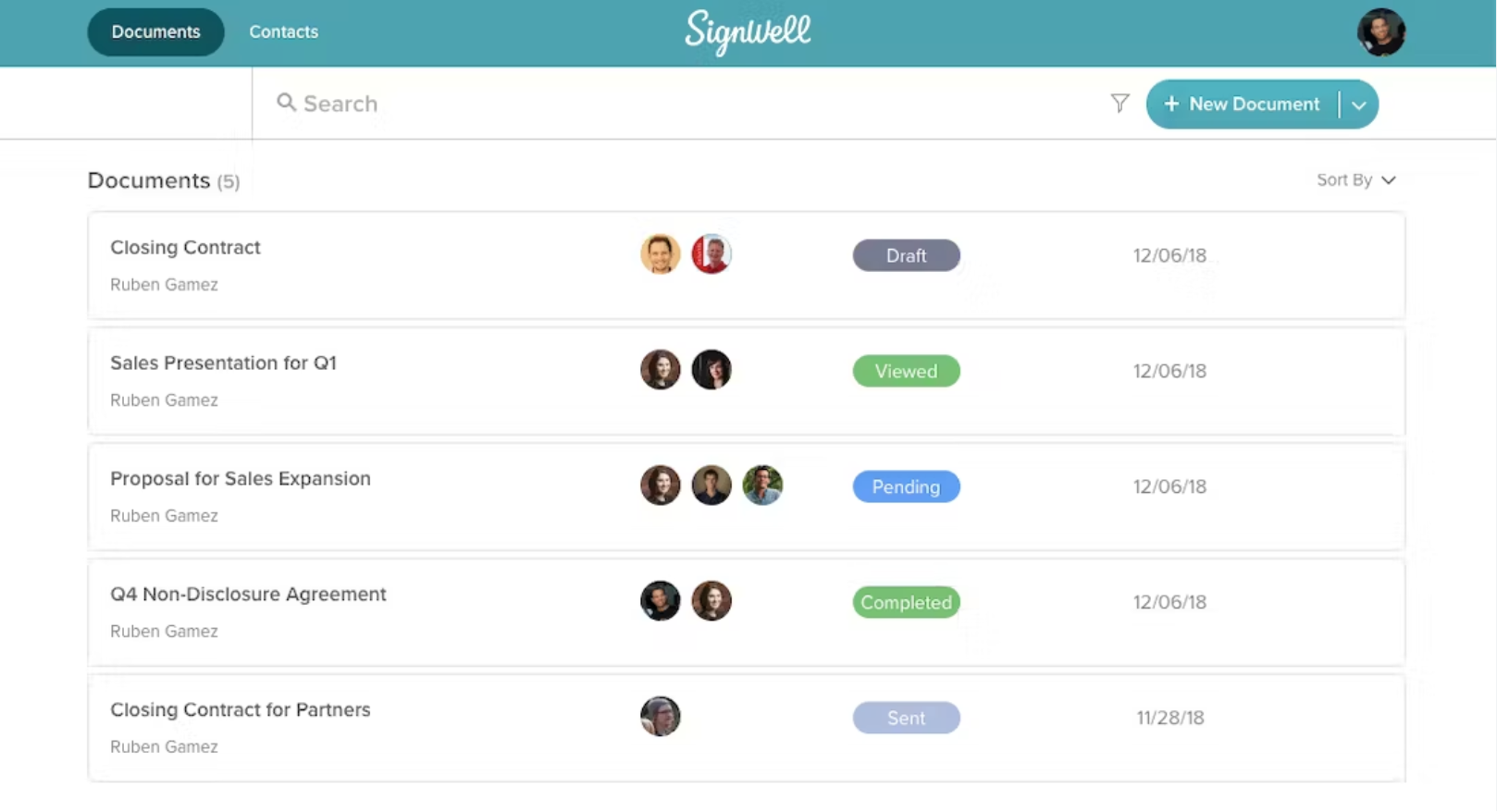Quick Summary
In this guide, we uncover how e-signatures are revolutionizing government operations with increased efficiency, lower costs, and greater transparency. Dive into the potential challenges and innovative solutions for seamless implementation. Our platform ensures secure document management across legal, healthcare, and government sectors. Embrace e-signatures to streamline your operations and stay ahead of compliance regulations.
Want to Know the Benefits of Electronic Signatures for the Government?
Did you know that electronic signatures can reduce the time required to process government documents? As governments worldwide embrace digital transformation, e-signatures are considered one of the best options for streamlining operations. They offer numerous benefits that can transform how public sector organizations handle paperwork and services.
In this SignWell guide, we explore the powerful advantages of e-signatures for government bodies. We’ll cover how they can elevate service delivery, enhance record-keeping, and reduce environmental impact—all while delivering significant cost savings and operational efficiencies.
Why Listen to Us?
At SignWell, we specialize in providing expert insights and solutions for digital transformation in the public sector. With extensive experience and a deep understanding of e-signature technology, we’ve helped numerous organizations successfully adopt secure, efficient, and compliant digital workflows.
Our knowledge is backed by industry best practices and real-world case studies, ensuring that transitioning from paper-based workflows to digital ones is efficient, helping government agencies save both time and money.

Benefits of Electronic Signature for Government
1. Increased Speed, Efficiency, and Convenience
Electronic signatures significantly speed up governmental processes. E-signatures can reduce government document response times by up to 80%. They accelerate decision-making, enabling governments to deliver quicker and more efficient services to citizens.
E-signatures also provide accessibility and convenience to a wide range of citizens because they offer:
- Remote access: People can sign and submit official documents from anywhere.
- 24/7 availability: It’s convenient for different work schedules.
- Language support: Government services are more accessible to non-native speakers.
- Simplified processes: Good e-signing platforms are user-friendly and offer guided workflows, making it easier for citizens to navigate complex government procedures.
E-signing platforms offer automation features to help reduce administrative delays. For instance, SignWell delivers features like bulk sending, signing orders, and automated reminders to support streamlined workflows across departments.

2. Cost Savings
E-signing offers considerable financial benefits to government bodies by eliminating expenses related to paper, printing, postage, and physical document storage. This method simplifies administrative procedures, cutting down on the time and labor costs involved in document management, which allows government employees to focus on more valuable tasks.
Additionally, e-signing is particularly beneficial for government agencies as it enhances transparency, improves record-keeping, and facilitates faster service delivery to citizens, ultimately leading to increased efficiency and better use of taxpayer resources.
3. Enhanced Security and Compliance
Electronic signatures support better security and government compliance in several key ways:
- Advanced encryption and authentication: E-signing platforms use advanced encryption algorithms and authentication methods to protect document integrity and verify signer identities.
SignWell offers advanced encryption and authentication methods, including AES-256 encryption for data at rest and in transit, to ensure the security and integrity of electronically signed documents.
- Detailed audit trails: Comprehensive audit trails track every action taken on a document, including who signed it, when, and from what device/location.
SignWell’s audit trails track data including timestamps, IP addresses, user identities, and more.
- Tamper-evident seals: Many e-signature platforms apply tamper-evident seals to signed documents, making it immediately apparent if any unauthorized changes have been made after signing.
- Compliance with regulations: E-signatures can be configured to meet various regulatory requirements, such as eIDAS, as indicated in the US. This ensures legal validity and compliance with government standards.
SignWell complies with the above regulations and several others, including UETA, GDPR, and SOC 2 Type 2.
- Secure storage and access controls: Documents are typically stored in secure cloud environments with strict access controls, reducing the risk of unauthorized access or document loss.
SignWell’s role-based access control (RBAC) allows administrators to manage permissions and ensure that only authorized individuals can access specific documents. We also maintain comprehensive audit trails to track every step in the document signing process, including timestamps and IP addresses.
- Integration with existing systems: Many e-signature systems integrate with government IT systems, allowing for seamless and secure document processing within security frameworks.
Through Zapier, we smoothly integrate with over 5,000 popular applications, including tools like Salesforce, Microsoft Dynamics, and various project management platforms, enabling easy incorporation into existing government IT systems and workflows.
4. Environmental Impact
Government adoption of e-signing can significantly reduce paper consumption, saving millions of trees and decreasing deforestation. For example, a shift to a fully digital document workflow enabled a telecommunications firm to save 84 paper reams annually.
E-signing lowers energy usage associated with paper production, printing, and physical document transportation. It also eliminates the need for storage space and climate-controlled archiving facilities, reducing energy consumption. Overall, e-signing helps governments to drastically cut their carbon footprint and promote more sustainable practices.
5. Increased Transparency and Accountability
Government transparency and accountability are crucial to building public trust, ensuring efficient use of resources, and maintaining the integrity of the democratic process. E-signing significantly enhances this in several ways:
- It offers precise record-keeping of all signatures and approvals, backed by comprehensive audit trails.
- E-signature platforms easily track document status and signatories, allowing government officials to monitor progress and identify bottlenecks in real time.
- The risk of lost or misplaced documents is significantly reduced.
- Platforms ensure that only authorized personnel can view or sign sensitive documents.
- It accommodates quick retrieval and review of signed documents, facilitating easier audits and investigations when needed.
Challenges of Electronic Signatures for Government and How to Overcome Them
Next, we’ll discuss some of the common challenges government agencies face in adopting electronic signatures and provide solutions.
1. Legal and Regulatory Concerns
Challenge: Governments must navigate complex legal frameworks to ensure electronic signatures comply with national and international laws, such as the ESIGN Act in the U.S. or eIDAS in the EU. Some agencies may also have outdated regulations requiring physical signatures.
Solution: Governments can adopt compliant platforms like SignWell that meet all legal standards and ensure their e-signature processes are legally binding and secure.
2. Security Concerns
Challenge: Security is a critical issue when adopting electronic signatures. Sensitive government documents must be protected against unauthorized access, tampering, or breaches.
Solution: Governments should address this by using platforms offering advanced encryption (AES 256-bit), multi-factor authentication, and audit trails. These security features ensure that documents are protected both in transit and at rest, and any access attempts or modifications are logged.
3. Change Management and Employee Training
Challenge: Introducing e-signature is a shift from a traditional paper-based process. Employees, officials, and citizens may be resistant to change or need more skills to use a new system efficiently.
Even though e-signatures offer numerous advantages, many organizations hesitate to incorporate this technology. The reasons vary—37% of non-adopters express worry that their customers may not feel comfortable using e-signatures, 36% express concerns about security and regulatory compliance issues, and 33% are apprehensive about the legal aspects of the process.
Solution: Provide comprehensive training and support for government employees. Run workshops and develop user-friendly guides for transition. Consider appointing “digital champions” within departments to help encourage adoption. Educate citizens on the proper use, tight security, and benefits of e-signatures to help them feel more at ease.
4. Cost Considerations
Challenge: Implementing e-signature systems, especially more advanced solutions, can be expensive for government agencies. There are several cost considerations to keep in mind:
- Initial upfront costs may include software licenses, infrastructure, and integration with existing systems.
- Training employees can be time-consuming and expensive.
- Ongoing maintenance and support, including regular updates, security patches, and technical support.
- Scalability costs: as usage increases, additional costs are typically needed to expand the system’s capacity.
Solution:
- Gradually roll out the e-signature system across departments to spread out costs and allow for budget allocation over time.
- Consider adopting a train-the-trainer approach. Train a core group of employees who can then train others, reducing overall training costs.
- Cloud-based e-signature platforms can reduce infrastructure costs and simplify maintenance.
- To reduce per-user costs, consider bulk licensing. Negotiate enterprise-wide licenses.
- Also, think about conducting a return on investment analysis to justify costs by highlighting long-term savings in paper, storage, and processing time.
5. Digital Divide and Accessibility
Challenge: Not all citizens have access to digital tools or the internet, making it difficult for some to participate in e-signature-based processes.
Solution: Governments should ensure that alternative methods (e.g., in-person services) are still available for those without access to digital devices. Additionally, investing in community digital literacy programs can help bridge the gap.
Conclusion
The adoption of electronic signatures in government processes is not just a trend, but an essential step towards increased efficiency, cost savings, enhanced security, better environmental sustainability, and improved transparency.
SignWell offers a robust, secure, and user-friendly platform that makes the transition straightforward and beneficial. Given its compliance with numerous legal standards and its advanced features designed for secure and seamless workflows, this platform stands out as a reliable choice for governments. Don’t let your organization get behind on this crucial tech integration.
Start your journey to a faster, more efficient, eco-friendly government using SignWell today.
Sign with a team that knows what you need.
Putting a signature on a document shouldn’t be hard. The SignWell mission? Simplify how documents get signed for millions of people and businesses.
Get Started Todaybusinesses served, so far...
total documents signed
customer support satisfaction